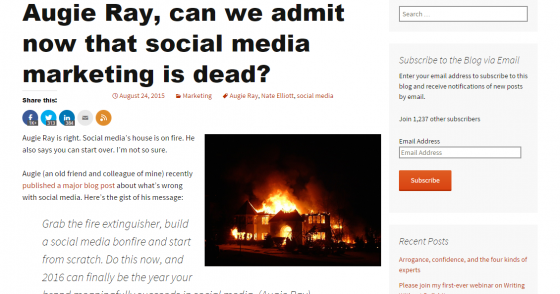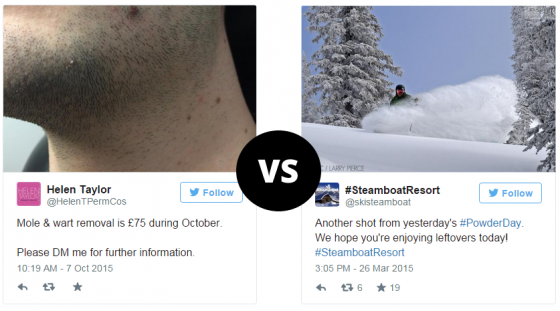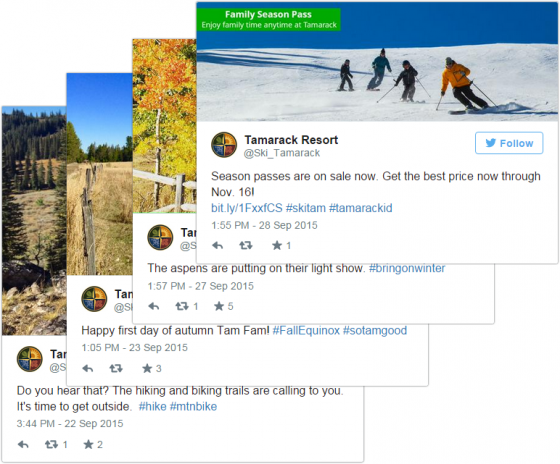Social Media
Is Social Media Marketing Dead? Are Gains Merely Illusions? Patrick Crawford Weighs In.


BLANCHARD
Is social media dead? We all have thoughts and some prominent names have recently shared theirs. For some solid perspective I turned to one of the smartest minds in the biz, Pat Crawford from Inkwell Media, for his take.
A few weeks ago I stumbled upon a blog post exchange with an apocalyptic headline: “Augie Ray, can we admit now that social media marketing is dead.”
Social media marketing is dead!
And the accompanying photo? A burning house.
The post was written by Josh Bernoff co-author Groundswell, a classic tome on social media, and was a long response to an even deeper post by Augie Ray. The whole exchange is great reading, but here’s the gist.
“Social Does Not Deliver Purchasers”
In the post that starts the exchange, Ray identifies some very real challenges facing social media:
Social does not deliver purchasers (accounting for 1% of e-commerce sales, compared to 16% for email and 17% for CPC). Social delivers poor conversions (with a conversion rate of 1.17% compared to 2.04% for search and 2.18% for email). Social fails to deliver trust (with B2B buyers rating social media posts among the least important for establishing credibility and just 15% of consumers trusting social posts by companies or brands.) Nor is Social media a major factor in search engine rankings (placing dead last among the nine major factors affecting SEO according to MoZ’s 2015 Search Engine Ranking Factors report.)
But despite these miserable stats, Ray believes that social can be redeemed as a communication channel for brands, if brands focus on generating actually useful content, creating word of mouth discussion and listening to customers better.
Fake WOM [word of mouth] gets people to click “like” on something the brand posted; real WOM gets people to tell others why they should trust, try and buy your product or service…
Your brand is disappearing from consumers’ news feeds (if it has not already), but friends will always see content from the people they know, care and trust. Stop trying to spark engagement using funny, clever, hip, edgy or inspirational content, and stop acting as if authentic peer-to-peer engagement can be bought by paying influencers to tweet about your brand. Find ways to get people talking to each other about their real experiences with your company and its offerings…
Bernoff agrees with Ray’s dismal view, but says social is beyond saving as marketing channel:
Nobody wants to talk about your brand. Nobody wants to interact with your marketing. Any gains you see are illusory. Social media is not a marketing channel. Give up.
His recommendation: Give your social media budget to ad buyers, turn your social into customer service channel and walk away.
Now it is just media. It’s like putting up ad signage at a rock concert. Yeah, lots of people see your ad, but it’s the concert they’re talking about, not you.
Give Bernoff credit for candor, but to me this exchange is subject to a broad over-generalization that all brands are essentially the same, and therefore must have the same community relationships and same goals. In reality, we all know that similarities are few between Coca-Cola’s social presence and that of a small ski area or niche snowsports company.
Perhaps Facebook doesn’t provide the highest return on ad spend for a consumer staple company, but I see every day that a variety of social media ads and content, employed in an intelligent strategy, can help companies communicate with their audiences in ways that build brand, and can convert directly or create value later when customers convert via SEM or join email newsletter lists.
You Click What You Love
How so? Both Ray and Bernoff point out that consumers expect brands to be present in their social feeds. Happily, most of us reading this post are lucky to be among the industries that that people also want to hear from on social media.
Sports are integral to our social identities. People want those exciting, visually stimulating photos and videos in our feeds, and in the right context, we are excited to share them. That photo of the first snow at your favorite resort is that one truly interesting thing breaking up the endless barrage of humblebrags about kids and The Donald.
Yes, people want to talk to each other on social, but they also want to share great content as a conversation starter. Take the “media” out of social, and actually make it just user-generated content, and the whole thing collapses. Instagram is the only channel that has a chance in that environment.
The Right Mix
It’s like Gary Vaynerchuk puts it in Jab, Jab, Jab, Right Hook — you give, give, give in the form of good content and audience engagement before you hit them with the hook and ask for a sale. With good content, good metrics and a mix of small paid boosts, you can absolutely see positive sales results via social.
Through some combination of paid and organic that is unique to your brand, social media are the platforms to reach your consumers. Let’s not forget, social media usage continues to rise, even at much-maligned Facebook.
Look at your Facebook post reach vs. website visits. Which is higher? As an agency, INKWELL sees quite a few examples, and Facebook reach is always higher, sometimes threefold, sometimes tenfold.
Social’s Rock Concert Effect
Bernoff compares social media to signage at a rock concert. It’s a valid comparison, but I’d rather work on making a memorable presence at a rock concert where everyone is already partying than on convincing everyone to leave the concert and come over to my house so I can show them my sign. In fact, social media is more like signage at a rock concert where everyone has already said they’re interested in your brand.
So, make content that tells your story on your website and on social media, but be realistic. Know you will have to pay for social media distribution, and that social media is just one piece of a matrix of social, email, web, search, partnerships, on-site and other channels.
Some pieces of content, like a video of the deepest day of the season, have a chance to take on life of their own. Reserve some budget to boost those stories to get the ball rolling. Others (maybe an interview with the head of ski school about new programs) are foundational stories that you need when your customers come to find you. That it never “goes viral” does not make it a failure. Make it as evergreen as possible, so you can use it for a long time.
This Time It’s (Not) Different
Throughout social media’s incredible rise, the feeling that “this time it’s different” has been inescapable. But as it turns out, social media is media. And communicating via media is a hard game. Finding your story is challenging; it’s labor-intensive to tell it and it’s a long-haul effort. If we remember that social media is not a magic marketing tool but a means of communication (sometimes one-way, sometimes two-way), then our perspective is more accurate.
@beartracks03 so many good ones! What level rider are you? (Here's what is open this weekend: http://t.co/Cu15v2yRrr)
— Vail (@vailmtn) October 2, 2015
What social has really done for marketing is drive transparency, and that’s truly scary. I’m not convinced that social media as a brand communication platform is dead; I’m convinced that social media is killing bullshit marketing. If you BS people, they’ll call you out on social. That’s what different.
The experience you give people and the way you tell that story must be worthy of social discussion. If you didn’t work for your company, would you share this post? Really think about it. If the answer to that is always no, then no means of communication will fix that problem.
About Gregg & SlopeFillers
I've had more first-time visitors lately, so adding a quick "about" section. I started SlopeFillers in 2010
with the simple goal of sharing great resort marketing strategies. Today I run marketing for resort ecommerce and CRM provider
Inntopia,
my home mountain is the lovely Nordic Valley,
and my favorite marketing campaign remains the Ski Utah TV show that sold me on skiing as a kid in the 90s.
Get the weekly digest.
New stories, ideas, and jobs delivered to your inbox every Friday morning.



